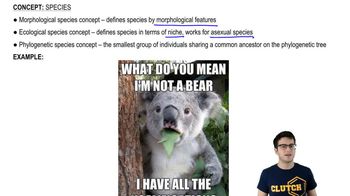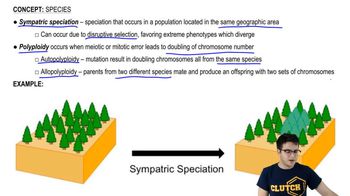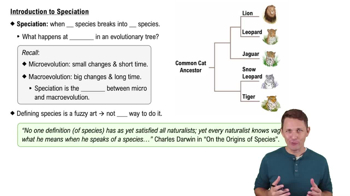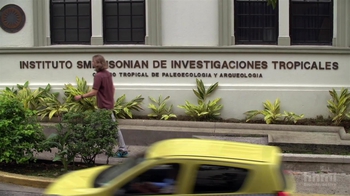Table of contents
- 1. Introduction to Biology2h 42m
- 2. Chemistry3h 40m
- 3. Water1h 26m
- 4. Biomolecules2h 23m
- 5. Cell Components2h 26m
- 6. The Membrane2h 31m
- 7. Energy and Metabolism2h 0m
- 8. Respiration2h 40m
- 9. Photosynthesis2h 49m
- 10. Cell Signaling59m
- 11. Cell Division2h 47m
- 12. Meiosis2h 0m
- 13. Mendelian Genetics4h 44m
- Introduction to Mendel's Experiments7m
- Genotype vs. Phenotype17m
- Punnett Squares13m
- Mendel's Experiments26m
- Mendel's Laws18m
- Monohybrid Crosses19m
- Test Crosses14m
- Dihybrid Crosses20m
- Punnett Square Probability26m
- Incomplete Dominance vs. Codominance20m
- Epistasis7m
- Non-Mendelian Genetics12m
- Pedigrees6m
- Autosomal Inheritance21m
- Sex-Linked Inheritance43m
- X-Inactivation9m
- 14. DNA Synthesis2h 27m
- 15. Gene Expression3h 20m
- 16. Regulation of Expression3h 31m
- Introduction to Regulation of Gene Expression13m
- Prokaryotic Gene Regulation via Operons27m
- The Lac Operon21m
- Glucose's Impact on Lac Operon25m
- The Trp Operon20m
- Review of the Lac Operon & Trp Operon11m
- Introduction to Eukaryotic Gene Regulation9m
- Eukaryotic Chromatin Modifications16m
- Eukaryotic Transcriptional Control22m
- Eukaryotic Post-Transcriptional Regulation28m
- Eukaryotic Post-Translational Regulation13m
- 17. Viruses37m
- 18. Biotechnology2h 58m
- 19. Genomics17m
- 20. Development1h 5m
- 21. Evolution3h 1m
- 22. Evolution of Populations3h 52m
- 23. Speciation1h 37m
- 24. History of Life on Earth2h 6m
- 25. Phylogeny2h 31m
- 26. Prokaryotes4h 59m
- 27. Protists1h 12m
- 28. Plants1h 22m
- 29. Fungi36m
- 30. Overview of Animals34m
- 31. Invertebrates1h 2m
- 32. Vertebrates50m
- 33. Plant Anatomy1h 3m
- 34. Vascular Plant Transport1h 2m
- 35. Soil37m
- 36. Plant Reproduction47m
- 37. Plant Sensation and Response1h 9m
- 38. Animal Form and Function1h 19m
- 39. Digestive System1h 10m
- 40. Circulatory System1h 57m
- 41. Immune System1h 12m
- 42. Osmoregulation and Excretion50m
- 43. Endocrine System1h 4m
- 44. Animal Reproduction1h 2m
- 45. Nervous System1h 55m
- 46. Sensory Systems46m
- 47. Muscle Systems23m
- 48. Ecology3h 11m
- Introduction to Ecology20m
- Biogeography14m
- Earth's Climate Patterns50m
- Introduction to Terrestrial Biomes10m
- Terrestrial Biomes: Near Equator13m
- Terrestrial Biomes: Temperate Regions10m
- Terrestrial Biomes: Northern Regions15m
- Introduction to Aquatic Biomes27m
- Freshwater Aquatic Biomes14m
- Marine Aquatic Biomes13m
- 49. Animal Behavior28m
- 50. Population Ecology3h 41m
- Introduction to Population Ecology28m
- Population Sampling Methods23m
- Life History12m
- Population Demography17m
- Factors Limiting Population Growth14m
- Introduction to Population Growth Models22m
- Linear Population Growth6m
- Exponential Population Growth29m
- Logistic Population Growth32m
- r/K Selection10m
- The Human Population22m
- 51. Community Ecology2h 46m
- Introduction to Community Ecology2m
- Introduction to Community Interactions9m
- Community Interactions: Competition (-/-)38m
- Community Interactions: Exploitation (+/-)23m
- Community Interactions: Mutualism (+/+) & Commensalism (+/0)9m
- Community Structure35m
- Community Dynamics26m
- Geographic Impact on Communities21m
- 52. Ecosystems2h 36m
- 53. Conservation Biology24m
23. Speciation
Introduction to Speciation
Problem 10`
Textbook Question
What prevents horses and donkeys from hybridizing to form a new species? a. limited hybrid fertility b. limited hybrid viability c. hybrid breakdown d. gametic isolation
 Verified step by step guidance
Verified step by step guidance1
Understand the concept of hybridization: Hybridization occurs when two different species mate and produce offspring. However, for a hybrid to lead to the formation of a new species, it must be fertile and capable of reproducing successfully over generations.
Review the reproductive barriers: Reproductive barriers are mechanisms that prevent species from interbreeding or producing viable, fertile offspring. These barriers can be prezygotic (before fertilization) or postzygotic (after fertilization).
Analyze the specific case of horses and donkeys: When horses and donkeys mate, they produce a hybrid offspring called a mule. However, mules are typically sterile, meaning they cannot reproduce to form a new species.
Identify the correct reproductive barrier: The sterility of mules is an example of a postzygotic barrier known as 'limited hybrid fertility,' which prevents the hybrid from contributing to the gene pool of a new species.
Match the correct answer to the question: Based on the explanation, the correct answer is 'a. limited hybrid fertility,' as it directly addresses the inability of the hybrid (mule) to reproduce and form a new species.
 Verified video answer for a similar problem:
Verified video answer for a similar problem:This video solution was recommended by our tutors as helpful for the problem above
Video duration:
1mPlay a video:
Was this helpful?
Key Concepts
Here are the essential concepts you must grasp in order to answer the question correctly.
Hybrid Fertility
Hybrid fertility refers to the ability of hybrid offspring to reproduce. In the case of horses and donkeys, they can produce a mule, which is typically sterile. This sterility prevents the hybrid from contributing to the gene pool of either parent species, thus limiting the potential for the formation of a new species.
Recommended video:
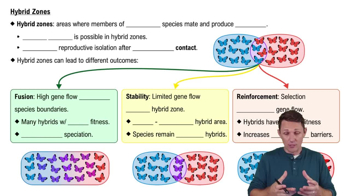
Hybrid Zones
Hybrid Viability
Hybrid viability is the ability of hybrid offspring to survive to reproductive age. While mules (the offspring of horses and donkeys) are usually healthy and viable, their inability to reproduce means that they do not contribute to the continuation of a new species. This concept highlights the importance of survival and reproductive success in speciation.
Recommended video:

Hybrid Zones
Gametic Isolation
Gametic isolation is a prezygotic barrier that occurs when the gametes (sperm and egg) of two species are incompatible, preventing fertilization. In horses and donkeys, even if mating occurs, the sperm may not successfully fertilize the egg due to differences in reproductive mechanisms, further preventing the formation of viable hybrids.
Recommended video:
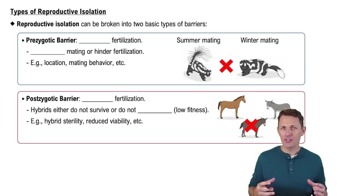
Types of Reproductive Isolation

 3:03m
3:03mWatch next
Master Introduction to Speciation with a bite sized video explanation from Jason
Start learningRelated Videos
Related Practice



